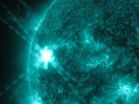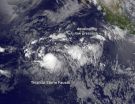(Press-News.org) SAN DIEGO – July 8, 2014 In a study published yesterday in the scientific journal Nature Immunology, a group at the La Jolla Institute (LJI) led by Pandurangan Vijayanand, Ph.D. identify new genes that likely contribute to asthma, a disease that currently affects over 200 million people world wide.
An organism's genetic material, also known as its genome, can be divided into small sections or 'neighborhoods.' Scientists can determine which genetic neighborhoods in a cell are active, or primed for gene production, by looking for a marker on the genome called an enhancer. An enhancer can increase the production of genes in its immediate neighborhood. The goal of the published study is to find genes whose neighborhoods are active in diseased cells, but inactive in healthy cells. Genes that are in active neighborhoods in diseased cells are likely to contribute to disease, and can potentially be targeted with drug treatments.
In order to find genetic neighborhoods that are active in asthmatic disease, the scientists in Vijayanand's group focus their experiments on memory cells, which develop abnormally in asthma patients. Memory cells are responsible for quickly responding to foreign substances called antigens that the host has been exposed to previously. Air passage inflammation, which characterizes asthma, is mediated by an overactive response to inhaled antigens by memory cells.
By applying his technique in small populations of abnormal memory cells, Vijayanand highlights 33 genetic neighborhoods that are highly active in diseased cells, but inactive in healthy cells, shifting the focus of asthma research to specific genes that are located in these neighborhoods.
Genome-wide association studies (GWAS) that are less precise, have previously identified 1,500 potential target regions associated with asthmatic disease. According to Vijayanand, these targets are too numerous to study individually, and as a result, the field has remained focused on just a few molecules for discovery of new asthma treatments. Using their approach, Vijayanand's team searched the 1,500 targets for those that have the greatest likelihood of contributing to asthmatic disease. "Our unbiased and hypothesis-free approach has revealed a staggering but manageable number of new molecules that could play a role in asthma, and thus are potentially novel therapeutic targets," said Vijayanand.
Vijayanand and his team completed the study using different amounts of cells from the blood of healthy individuals and asthmatic patients. They did so in order to determine the smallest number of cells that were required for their technique, and found that it works with as little as 10,000 cells, which is significantly less than the millions of cells required to use other methods. Vijayanand envisions using this technique in situations where access to cells is limited, such as tumor biopsy for cancer.
The frequency of asthma is rising across the developed world as well as in several large developing countries. Treatment for asthma usually includes long-term nonspecific medication, as there is no cure at present.
Vijayanand says this study provides information that can be the starting point for many avenues of research and treatment. He says, "our study provides a rich and comprehensive resource that will be useful to the scientific community, enabling investigators to conduct their own detailed studies of the functional significance of the novel genes and enhancers that we have identified."
INFORMATION:
The findings were published in a Nature Immunology paper entitled "Epigenomic analysis of primary human T cells reveals enhancers associated with TH2 memory cell differentiation and asthma susceptibility." The study was supported in part by the National Institutes of Health, under grant numbers R01 HL114093 and U19 AI100275.
Researchers from other institutions also contributed to this study, including those from Southampton National Institute for Health Research and University of California, San Francisco.
About La Jolla Institute
Founded in 1988, La Jolla Institute for Allergy and Immunology is a nonprofit, independent biomedical research institute focused on improving human health through increased understanding of the immune system. Its scientists carry out research seeking new knowledge leading to the prevention of disease through vaccines and the treatment and cure of infectious diseases, cancer, inflammatory, and autoimmune diseases such as rheumatoid arthritis, type 1 (juvenile) diabetes, Crohn's disease and asthma. La Jolla Institute's research staff includes more than 150 Ph.D.s and M.D.s. To learn more about the Institute's work, visit http://www.lji.org.
LJI develops new approach to identify genes poised to respond in asthma patients
Study searches active genetic neighborhoods for genes that can be targeted to treat asthmatic disease
2014-07-08
ELSE PRESS RELEASES FROM THIS DATE:
Astronomers bring the third dimension to a doomed star's outburst
2014-07-08
VIDEO:
NASA Goddard astrophysicists Ted Gull and Tom Madura discuss Eta Carinae and their new model of the Homunculus Nebula, a shell of gas and dust ejected during the star's mid-19th...
Click here for more information.
In the middle of the 19th century, the massive binary system Eta Carinae underwent an eruption that ejected at least 10 times the sun's mass and made it the second-brightest star in the sky. Now, a team of astronomers has used extensive new observations to create ...
NASA's SDO spots a summer solar flare
2014-07-08
The sun emitted a mid-level solar flare, peaking at 12:20 p.m. EDT on July 8, 2014, and NASA's Solar Dynamics Observatory captured images of the event. Solar flares are powerful bursts of radiation. Harmful radiation from a flare cannot pass through Earth's atmosphere to physically affect humans on the ground, however -- when intense enough -- they can disturb the atmosphere in the layer where GPS and communications signals travel.
To see how this event may affect Earth, please visit NOAA's Space Weather Prediction Center at http://spaceweather.gov, the U.S. government's ...
NASA-JAXA's new precipitation satellite sees first Atlantic hurricane
2014-07-08
VIDEO:
The animation begins with global infrared data showing the progression of the storm as it forms into a hurricane. Then GPM flies overhead measuring rain rates on the ground. GPM's...
Click here for more information.
The Global Precipitation Measurement (GPM) Core Observatory flew over Hurricane Arthur five times between July 1 and July 5, 2014. Arthur is the first tropical cyclone of the 2014 Atlantic hurricane season.
GPM is a joint mission between NASA and the Japan ...
Satellite sees newborn Tropical Storm Fausto being 'chased'
2014-07-08
Tropical Storm Fausto was literally born yesterday and strengthened to a tropical storm quickly. Satellite imagery from NOAA's GOES-West satellite shows a rounded Fausto being "chased" by a developing area of low pressure to the east of the storm.
NOAA's Geostationary Operational Environmental Satellite GOES-West captured a combination visible and infrared image of the Eastern Pacific on July 8 at 1500 UTC (10 a.m. EDT). In the image, Tropical Storm Fausto appeared as a rounded area of clouds, compared to the amorphous developing low pressure area behind it.
At 6:30 ...
NCI study finds extreme obesity may shorten life expectancy up to 14 years
2014-07-08
Adults with extreme obesity have increased risks of dying at a young age from cancer and many other causes including heart disease, stroke, diabetes, and kidney and liver diseases, according to results of an analysis of data pooled from 20 large studies of people from three countries. The study, led by researchers from the National Cancer Institute (NCI), part of the National Institutes of Health, found that people with class III (or extreme) obesity had a dramatic reduction in life expectancy compared with people of normal weight. The findings appeared July 8, 2014, in ...
Virtual reality crowds produce real behavior insights
2014-07-08
VIDEO:
Researchers at Brown University have developed a wireless virtual reality system to better understand how pedestrians interact with one another and generate patterns of crowd movement.
Click here for more information.
PROVIDENCE, R.I. [Brown University] —The cognitive scientists in the Virtual Environment Navigation lab at Brown University are not only advancing a frontier of behavioral research but also of technology.
Led by Professor William Warren, the group developed ...
Three reforms to protect California's cap-and-trade policy
2014-07-08
California's landmark cap-and-trade system for regulating greenhouse gases could be vulnerable to price spikes and market manipulation, according to a new study released by scholars affiliated with the Energy Institute at Haas. But the state's air-quality regulators can prevent that outcome with three straightforward reforms, the study says.
Specifically, the California Air Resources Board should consider (1) strengthening the new market's price collar—the so-called allowance price containment reserve—(2) allowing permits to be converted from one compliance period to ...
Planet Mercury a result of early hit-and-run collisions
2014-07-08
TEMPE, Ariz. - Planet Mercury's unusual metal-rich composition has been a longstanding puzzle in planetary science. According to a study published online in Nature Geoscience July 6, Mercury and other unusually metal-rich objects in the solar system may be relics left behind by collisions in the early solar system that built the other planets.
The origin of planet Mercury has been a difficult question in planetary science because its composition is very different from that of the other terrestrial planets and the moon. This small, innermost planet has more than twice ...
Using sand to improve battery performance
2014-07-08
RIVERSIDE, Calif. (http://www.ucr.edu) — Researchers at the University of California, Riverside's Bourns College of Engineering have created a lithium ion battery that outperforms the current industry standard by three times. The key material: sand. Yes, sand.
"This is the holy grail – a low cost, non-toxic, environmentally friendly way to produce high performance lithium ion battery anodes," said Zachary Favors, a graduate student working with Cengiz and Mihri Ozkan, both engineering professors at UC Riverside.
The idea came to Favors six months ago. He was relaxing ...
UI researchers find early predictor for preeclampsia
2014-07-08
University of Iowa researchers have discovered a biomarker that could give expecting mothers and their doctors the first simple blood test to reliably predict that a pregnant woman may develop preeclampsia, at least as early as 6 weeks into the pregnancy.
Preeclampsia is a cardiovascular disorder generally occurring late in pregnancy and often resulting in an early delivery, creating immediate and potentially lifelong risks to both mother and baby. It causes high blood pressure and protein in the urine, and is typically diagnosed in the late second or third trimester ...
LAST 30 PRESS RELEASES:
S-species-stimulated deep reconstruction of ultra-homogeneous CuS nanosheets for efficient HMF electrooxidation
Mechanical and corrosion behavior of additively manufactured NiTi shape memory alloys
New discovery rewrites the rules of antigen presentation
Researchers achieve chain-length control of fatty acid biosynthesis in yeast
Water interactions in molecular sieve catalysis: Framework evolution and reaction modulation
Shark biology breakthrough: Study tracks tiger sharks to Maui mating hub
Mysterious iron ‘bar’ discovered in famous nebula
World-first tool reduces harmful engagement with AI-generated explicit images
Learning about public consensus on climate change does little to boost people’s support for action, study shows
Sylvester Cancer Tip Sheet for January 2026
The Global Ocean Ship-Based Hydrographic Investigations Program (GO-SHIP) receives the Ocean Observing Team Award
Elva Escobar Briones selected for The Oceanography Society Mentoring Award
Why a life-threatening sedative is being prescribed more often for seniors
Findings suggest that certain medications for Type 2 diabetes reduce risk of dementia
UC Riverside scientists win 2025 Buchalter Cosmology Prize
SETI Institute opens call for nominations for the 2026 Tarter Award
Novel theranostic model shows curative potential for gastric and pancreatic tumors
How beige fat keeps blood pressure in check
Fossils reveal ‘latitudinal traps’ that increased extinction risk for marine species
Review: The opportunities and risks of AI in mental health research and care
New map reveals features of Antarctic’s ice-covered landscape
Beige fat promotes healthy vascular function and blood pressure in mice
Chronic low-dose pesticide exposure reduces the life span of wild lake fish, China-based study shows
Tiny earthquakes reveal hidden faults under Northern California
Long-term pesticide exposure accelerates aging and shortens lifespan in fish
Professor Tae-Woo Lee's research group develops groundbreaking perovskite display technology demonstrating the highest efficiency and industry-level operational lifetime
The “broker” family helps tidy up the cell
Ecology: Mummified cheetahs discovery gives hope for species’ Arabic reintroduction
Researchers survey the ADHD coaching boom
Air pollution and cardiac remodeling and function in patients with breast cancer
[Press-News.org] LJI develops new approach to identify genes poised to respond in asthma patientsStudy searches active genetic neighborhoods for genes that can be targeted to treat asthmatic disease






